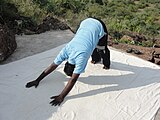Adhomukha Shvanasana

19th century Mysore Palace manuscript.
Adhomukha Shvanasana ( Sanskrit अधोमुखश्वानासन IAST Downward Facing Dog Position , German , lowering show Hund ' ) is a classic practice of yoga and one of the 84 main exercises of Hatha Yoga . The Sanskrit name is made up of the words adhas ( Sanskrit अधस् , below ' ), mukha ( Sanskrit मुख , face ' ), Svanå ( Sanskrit श्वान , dog ' ) and āsana ( Sanskrit आसन , seat or posture ' ). It occurs in the so-called " sun salutation ".
The name does not appear in any known medieval or earlier source of Hatha Yoga. A similar pose, called the elephant pose, is described in an 18th century hatha yoga guide.
Physical execution
This position is in the shape of an inverted "V". Heels and hands are on the floor, arms in line with the body, legs straight. There is an approximately right angle between the body and the legs. The palms are "rooted" on the ground. It is not necessary that the entire heel is on the ground, it is sufficient that the toes are in contact with the ground. The buttocks are at the very top. There are different ways to get into this position, depending on the yoga school.
- At Iyengar Yoga you lie first. The hands are brought to the appropriate place around the chest and the buttocks are lifted.
- In Sivananda Yoga , the position is part of the sun salutation and follows, for example, the dog looking up, lifting the buttocks as you exhale.
Effects
The exercise has positive effects on the musculoskeletal system , especially as it stretches the sciocrural muscles .
Although pregnancy was previously considered a contraindication , later research has shown that the exercise (among other yoga exercises) can have a positive effect.
Various 20th century gurus, such as BKS Iyengar , claimed that yoga had beneficial effects on various organs, but without scientifically accepted evidence.
Web links
Individual evidence
- ↑ Search results "adhas". In: spokensanskrit.org . Retrieved April 29, 2020 .
- ↑ Search results "mukha". In: spokensanskrit.org . Retrieved April 29, 2020 .
- ↑ Search results "svAna". In: spokensanskrit.org . Retrieved April 29, 2020 .
- ↑ "Asana" search results. In: spokensanskrit.org . Retrieved April 29, 2020 .
- ↑ James Mallinson, Mark Singleton: Roots of Yoga . Penguin Books, 2017, ISBN 978-0-241-25304-5 , pp. 95, 124 .
- ↑ a b B. KS Iyengar: Light on Yoga: Yoga Dipika . Unwin Paperbacks, 1979, pp. 110-111 (English).
- ^ Lucy Lidell: The Book of Yoga: the complete step-by-step guide . Ed .: The Sivananda Yoga Center . Ebury, 1983, ISBN 0-85223-297-7 , pp. 34-35 (English).
- ↑ Ann Swanson: Science of yoga: Understand the anatomy and physiology to perfect your practice . DK Publishing, New York 2019, ISBN 978-1-4654-7935-8 , pp. 124-127 (English).
- ^ Rachael L. Polis, Debra Gussman, Yen-Hong Kuo: Yoga in Pregnancy . In: Obstetrics & Gynecology . tape 126 , no. 6 , 2015, ISSN 0029-7844 , p. 1237–1241 , doi : 10.1097 / AOG.0000000000001137 (English): “All 26 yoga postures were well-tolerated with no acute adverse maternal physiologic or fetal heart rate changes.”
- ^ Suzanne Newcombe: Yoga in Britain: Stretching Spirituality and Educating Yogis . Equinox Publishing, Bristol, England 2019, ISBN 978-1-78179-661-0 , pp. 203-227 (English).
